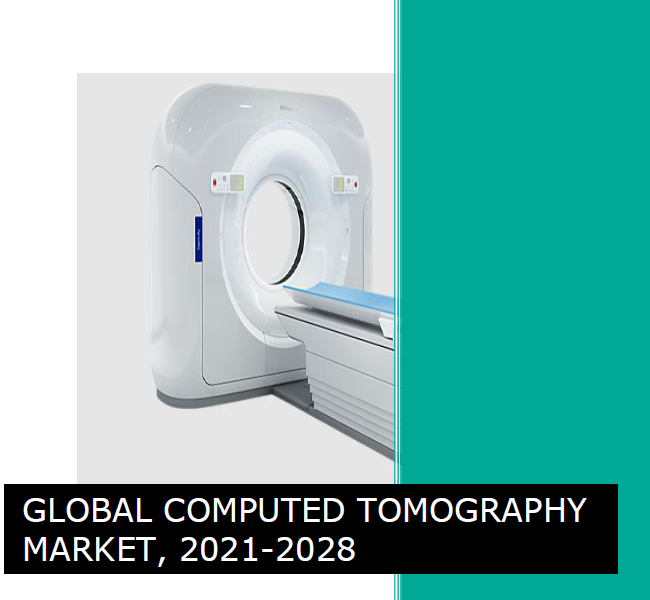Introducing Single Price Syndicate Report

GLOBAL COMPUTED TOMOGRAPHY MARKET
MARKET ANALYSIS & SEGMENT FORECAST FROM 2021 TO 2028Global Computed Tomography Market Size, Share & Trends Analysis Report By Technology Type (High-end slice, Mid end slice, Low-end slice, and Cone beam -CBCT), By Application (Cardiovascular, Oncology, Neurovascular, Musculoskeletal, and other applications), By End-User (Hospital and clinics, Diagnostic centers, and Others), By Region (North America, Europe, Asia-Pacific, South America, and Middle East & Africa) And Segment Forecasts, 2021 - 2028
Published Date: TBD
Base Year for Estimate: 2020
Report ID: KYMGLHC03
Format: Electronic (PDF)
Number of Pages: TBD
Price: USD 5000
Market Outlook
Market Size & Forecast (2021-2028)
Segment Analysis (2021-2028)
Market Drivers & Restraints
COVID-19 Impact Analysis
Competitive Landscape & Company Profiles
KOL Commentary (Primary Research)
Session With Analyst
Computed tomography is a digitalized X-ray imaging method that creates a detailed image of internal organs, bones, soft tissue, and blood vessels to diagnose them. Computed tomography combines X-rays and computer technology, to help doctors to spot cancers and other problems, that aren't visible (or even visible) on standard X-rays.
Computed tomography is widely used to identify circulatory system disorders, spinal issues, kidney and bladder stones, abscess, inflammatory diseases including ulcerative colitis and sinusitis, and head, skeletal system, and internal organ trauma, among other things.
Computed tomography has a great impact on the understanding of illness, both in terms of its clinical uses and the role it has played in increasing our understanding of the disease. Computed tomography has aided important breakthroughs in illness diagnosis and management by allowing a deeper understanding of anatomy, physiology, and pathology.
Market Growth Factors:
- Increasing adoption of medical imaging: Medical imaging is an essential component of the whole healthcare process. Technical advancements, physician and patient demand, a dedication to providing excellent health care, and strong financial incentives are all contributing to a rapid rise in the adoption of medical imaging.
- Rising demand for analytics solutions: Analytics solutions that may assist medical imaging specialists to offer more value by lowering the length of stay, enhancing compliance, boosting income, minimizing medical mistakes and medical-legal risk, and assessing outcomes and quality will see increased attention and demand. Thus, this shift of medical care toward more profound data integrated image-guided interventions will contribute towards the growth of the computed tomography market.
- Rising geriatric population and increasing prevalence of chronic disease and complex medical conditions: According to the International Osteoporosis Foundation (IOF), one in every three women and one in every five men aged 50 and over suffers from osteoporosis-related fractures, affecting about 200 million individuals globally, with a fracture occurring every three seconds. A computed tomography scan creates three-dimensional pictures of bones, allowing for more accurate diagnosis and surgery in orthopedics. As a result of the growing prevalence of orthopedic diseases, demand for computed tomography scanners is projected to rise as well.
Market Drivers and restraints:
Drivers:
- Rising prevalence of cancer: The worldwide cancer burden continues to rise. A computed tomography scan is one of the most used tests for detecting cancer and determining the form and size of a tumor. Since the number of incident instances of cancer rises, so will the number of cancer survivors, increasing the number of diagnoses performed, as cancer patients live longer following diagnosis. Thus, boosting the market revenue.
- Product improvements and innovations: The development of devices to improve the picture quality acquired by traditional computed tomography scanners is likely to be one of the main drivers driving market expansion. Advanced cone-beam computed tomography (CBCT) devices are predicted to be a key element in expanding computed tomography's uses in current medical testing.
- Rising healthcare reforms: Health systems are looking for computed tomography systems that can increase the efficiency of complex workflows and wide case combinations for outpatient and emergency settings, from polytrauma to light headaches, or enhance medical competence. As health systems enhance operational efficiency and maintain patient happiness, they continue to optimize dosage and increase procedure uniformity. Traditional CT systems that have been established are unable to meet these dynamic problems.
- Technological Advancements in Computed Tomography (CT): Significant technical developments have been experienced by computed tomography that has improved cancer detection, reduced inpatient time, and aided surgery preparation. Computed tomography scan technology has advanced in recent years, decreasing hazardous radiation to patients, permitting quicker scan speeds, and improving picture quality. New and updated software allows for better picture reconstruction while also providing a new level to image interpretation. Hence, all these factors are expected to boost the market growth.
Restraints:
- Stringent manufacturing regulations: The computed tomography market is expected to be hampered to some extent by strict rules governing the manufacture of computed tomography equipment. Regulations frequently increase in the approval time for new goods, further impacting the market, because producers of these systems are obliged to follow strict quality standards in manufacturing.
- Risk of adverse effects of computed tomography impacting the adoption rate: Concerns regarding radiation exposure from medical imaging has grown because of recent publicity on the fast rise in imaging use because of the relatively high ionizing radiation dose in each examination and the huge number of people that are exposed associated with computed tomography scanning. Thus, it may impact the adoption of these systems in the market.
Market Developments:
- Increasing development in the field of personalized medicine: Personalized medicine is a valuable tool for understanding the illness process before clinical symptoms arise and enabling physicians to pick tailored treatments for patient management as the burden of chronic diseases rises. With the advancement of knowledge of the biomedical domain and the empowerment of artificial intelligence, machine learning methods, and deep learning methods, personalized medicine has become an attraction point in many research fields. Computed tomography will not only be able to give anatomical information regularly, but it will also be able to define structures based on their material makeup in a single scan. This will change and improve clinical pathways to personalized medicine
- Shift to Value-based healthcare: The shift to a value-based payment healthcare system has altered what hospitals are looking for in terms of return on investment, cost-effectiveness, efficiency, and patient safety. Hospitals must become more efficient and productive, which necessitates a move to more value-oriented goods. Similarly, patients have been more proactive in their care, resulting in a quality change. Data integration ("Big Data") and population health management are two trends that have emerged because of the transition to value-based care. An inflow of data, along with advances in imaging, allows these data to be used to not only provide more value but also to be applied to a larger population.
- Introduction of computed tomography into other sectors: Beyond the use, as a research tool, computed tomography is now utilized in a wide range of applications, including process and product development, process and product monitoring, sample through inspection procedures, product metrology, and full-scale failure investigation and forensics work. Recent computed tomography technology advances and software enhancements have demonstrated that picture quality may be improved while cycle durations are reduced. These advancements, along with improved methods, present significant potential for businesses to profit from CT in their day-to-day operations while also aiding in the development of new, high-quality goods.
Region-wise developments:
As more cancer cases and chronic illnesses are anticipated to be discovered as the population ages. The growing elderly population in the USA is responsible for the market growth of computed tomography. Because computed tomography is a crucial tool in lung cancer imaging, the rising prevalence of lung cancer in European nations is projected to fuel growth in that region.
Due to significant unmet requirements and expanding healthcare infrastructure in the Asia-Pacific area, particularly in quickly developing nations such as India and China. Furthermore, the region's market expansion is projected to be aided by the existence of key industry competitors and suppliers, the incidence of chronic diseases, and the rising presence of numerous insurance companies paying computed tomography scans. Hence, all these factors are expected to boost the market growth in different regions.
The report covers the following major segments of the Global Fog Computing market:
- By Technology Type: High-end slice, Mid end slice, Low-end slice, and Cone beam (CBCT)
- By Application: Cardiovascular, Oncology, Neurovascular, Musculoskeletal, and other applications
- By End-user: Hospital and clinics, Diagnostic centers, and others
- By Region: North America, Europe, Asia-Pacific, South America, and META
Report Related Frequently Asked Questions?
Buy full detailed market research report to get full insights!
